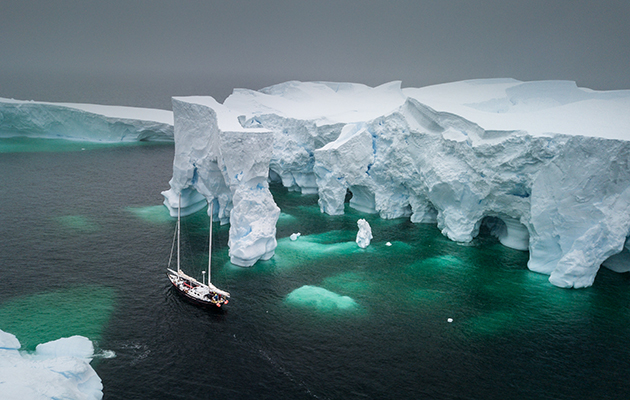Yacht cruising within the Arctic Circle has become increasingly popular,
but what is the best type of yacht for the job? Duncan Kent investigates
A guide to high latitude yachts
In 2012, former Royal Marine officer and award-winning explorer, Bob Shepton, traversed the North West Passage east to west in his 1980 GRP Westerly Discus, Dodo’s Delight, followed by a west-to-east in 2013.
Some might doubt that an old Westerly is the right vessel for such a daunting passage, but Bob liked his original boat so much, which was destroyed by fire in 2005 whilst wintering in the ice off Greenland, that he bought an identical model to replace her.
Other intrepid high latitude adventurers, David and Judy Lomax, were also very satisfied with their production GRP Beneteau First 345, Cloud Walker, during their frequent Norwegian and Arctic explorations.

Metal hulls are usually well insulated – essential when cruising in Arctic conditions. Credit: Benedict Gross
Ideally, though, if planning to use a GRP hull we would advise you look out for one with an integral steel floor frame and a watertight crash bulkhead forward.
It’s also sensible to reinforce around the waterline and stem with Kevlar sheathing.
The most popular hulls for high latitude sailing are made from metal. Initially, these were predominantly made from steel, but steel boats commonly require an inordinate amount of tedious maintenance.
More recently aluminium hulls have become the norm for such specialist exploration yachts.

Duncan Kent is a marine journalist and author of Choosing and Buying a Yacht
No sailing yacht is going to have the design or displacement to break through solid ice, even those with heavy steel hulls, but metal hulls do have the advantage of being resistant to abrasion, which is important in high latitude waters as even the broken ‘bergy bits’ of land ice can seriously damage paint and gelcoat along the waterline after a while.
An unpainted aluminium alloy hull has a naturally protective layer of oxide on its surface, which is self-repairing and, as such, won’t suffer from this common problem.
Metal hulls are usually well insulated – a vitally important element when tackling the constantly cold and unpredictable weather patterns of the Polar regions.
Clearly, a good heater, or heating system is essential, but it’s no good having an efficient heater if condensation is dripping off the hull and onto your bedding and upholstery.
Double-glazing will also help retain the warmth and stop the drips, and some even fit foam blinds over both the frame and glass to help stop condensation forming.
On-deck protection from the elements is equally important. A stout, usually rigid sprayhood or doghouse will keep the worst of the weather out and, for those without a deck saloon, a durable cockpit tent with see-through side and stern panels, plus a heater outlet if possible, will allow you to spend time at anchor admiring the stunning scenery that would otherwise be missed when huddling below.
Other design factors well worth considering are draft and freeboard.
A boat that can sail in just a few feet of water is unlikely to be confronted with large chunks of floating ice and tall topsides protect the rig from ice damage (they also help keep polar bears from boarding!).
Hardcore enthusiasts planning to winter on the ice usually pick a rounded bilge too, so that the hull rises up easily onto the top of the ice.
Mast steps can also be very useful when trying to spot safe routes (leads) through the ice ahead.
Fitting out for the Arctic
A good deal of suitability for high latitude sailing is what you put into the boat and not what type of vessel she actually is, although generous stowage for fuel, water and food goes without saying.
It is imperative that all the systems are simple, reliable and easy to maintain. You’ll need plenty of spares and accessible space to store them, plus printed manuals for everything.
Some means of receiving up-to-date weather information is imperative, as the Arctic climate suffers from constant and very rapid changes.

A solid fuel or diesel stove will keep things warm on board when sailing in high latitudes
Credit: KM Yachtbuilders
Navigation can also prove tricky, with some areas, such as eastern Greenland, barely charted.
Some say the numerous uncharted rocks are more of a hazard than the icebergs, especially at night.
Long lines (100m) and ice stakes are useful for tying up if anchoring proves too difficult.
If it’s a GRP boat then stout poles for fending off large lumps of floating ice are essential.
A standalone, drip-fed stove is a real boon, even if you have forced air diesel heaters, as it offers concentrated warmth for when you first go below and, more importantly, if you rig up a ‘cage’ around it, you can dry all your wet clothing.
Fresh water can be difficult to find in higher latitudes, so if you don’t want to waste time (and more importantly, energy) melting snow, you’ll need a suitable water maker.
Enjoyed reading A guide to high latitude yachts?
A subscription to Yachting Monthly magazine costs around 40% less than the cover price.
Print and digital editions are available through Magazines Direct – where you can also find the latest deals.
YM is packed with information to help you get the most from your time on the water.
-
-
- Take your seamanship to the next level with tips, advice and skills from our experts
- Impartial in-depth reviews of the latest yachts and equipment
- Cruising guides to help you reach those dream destinations
-
Follow us on Facebook, Twitter and Instagram.





